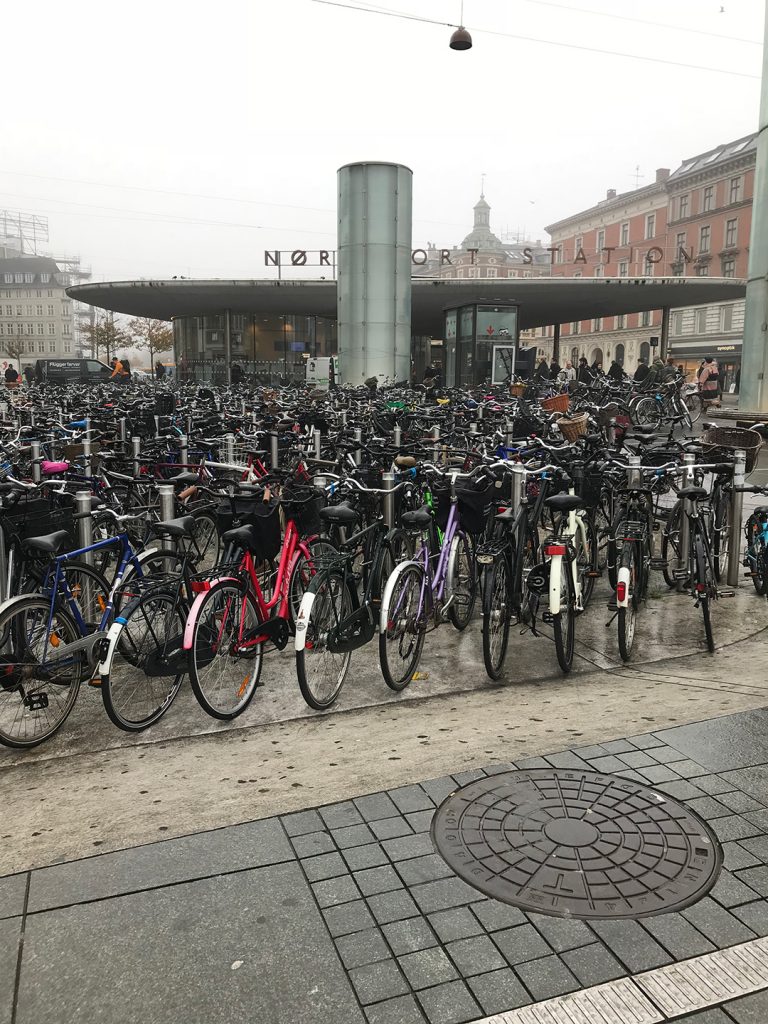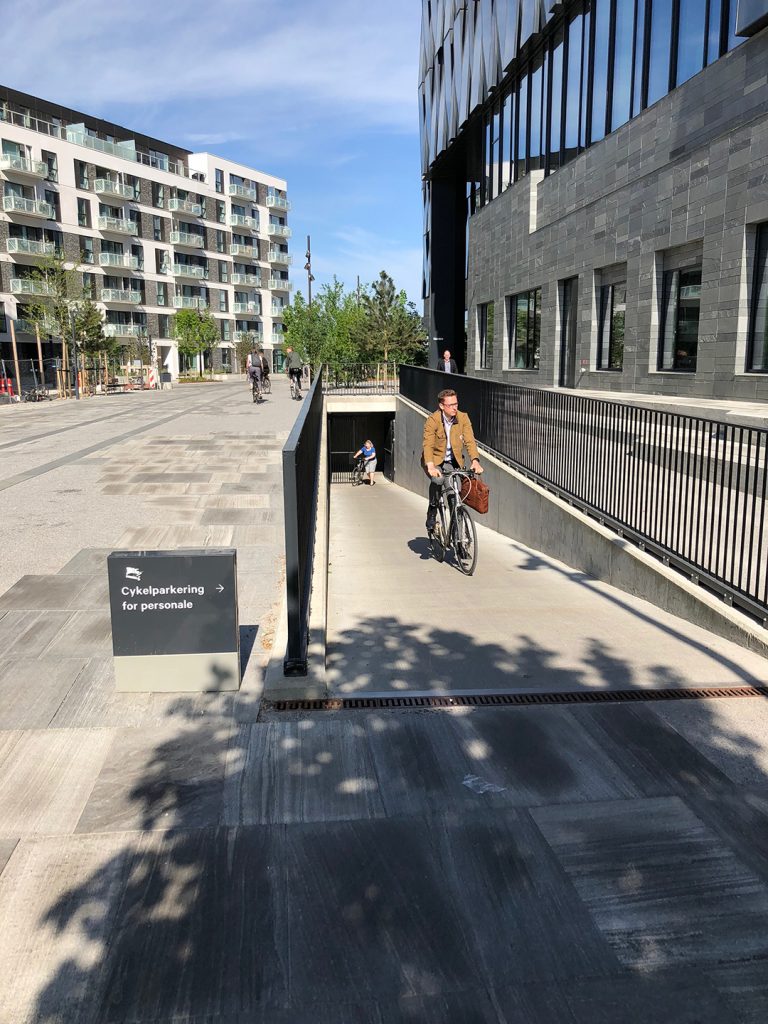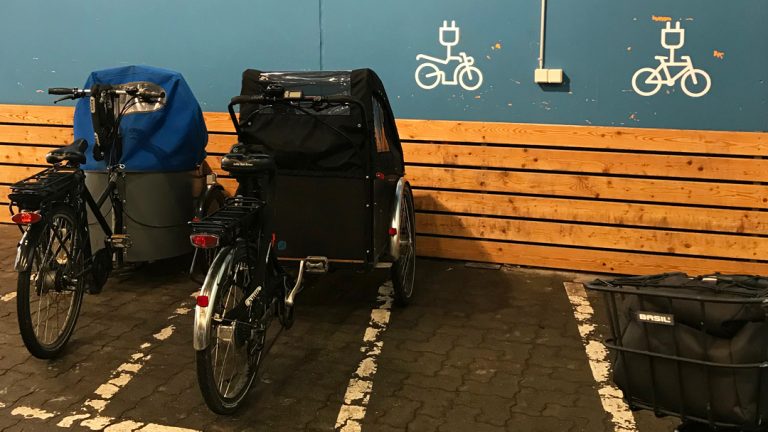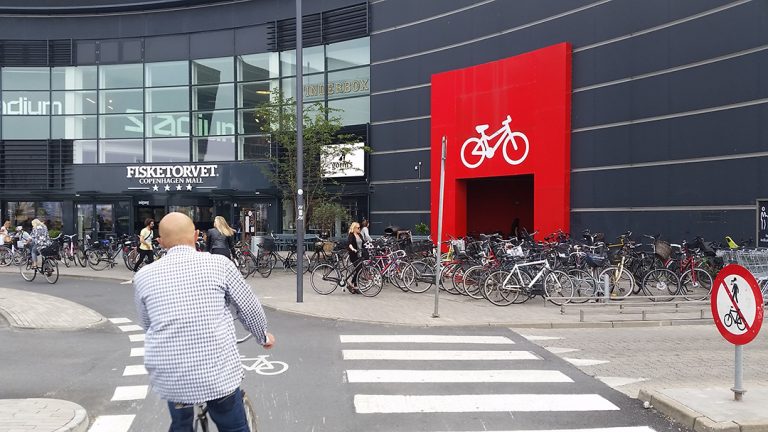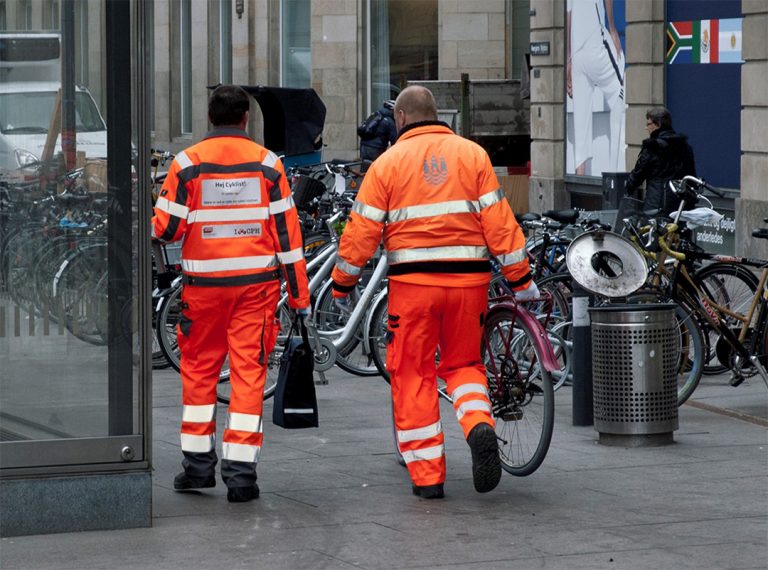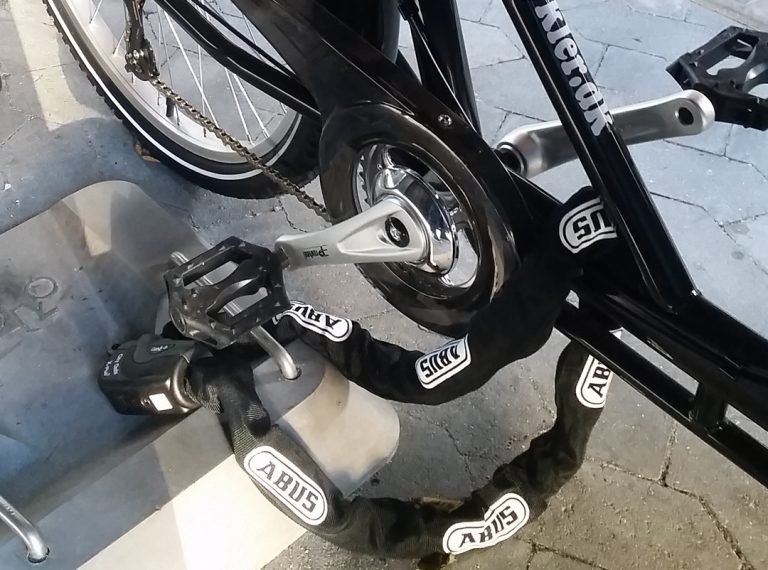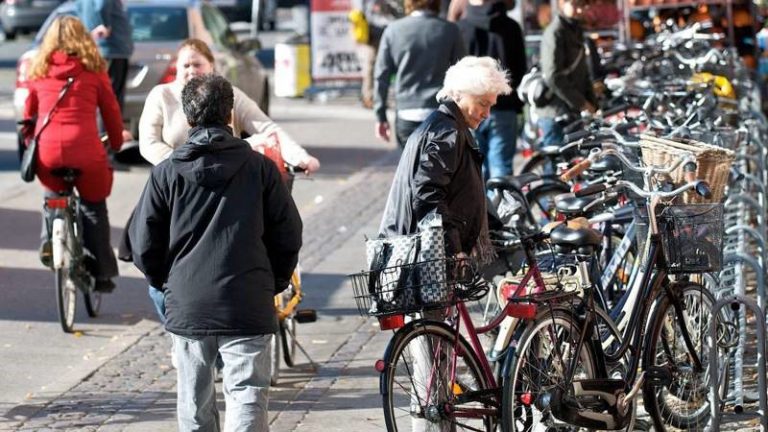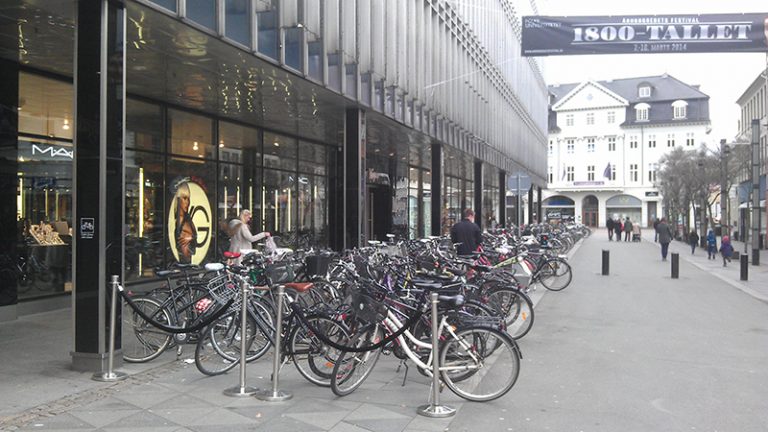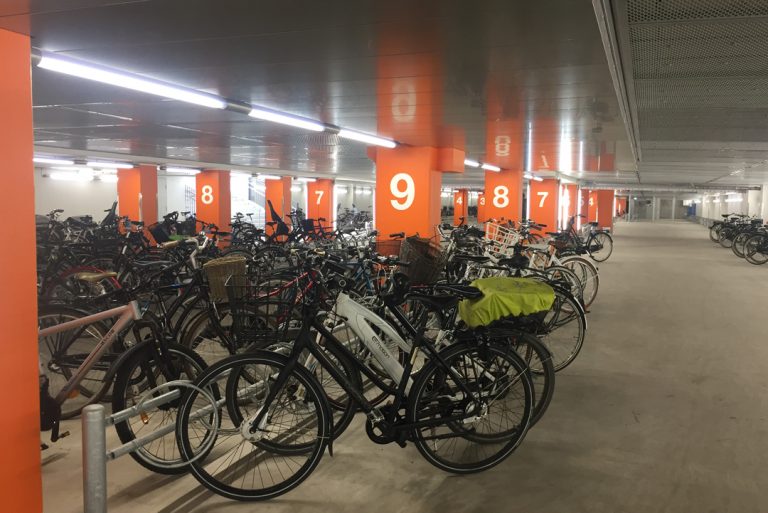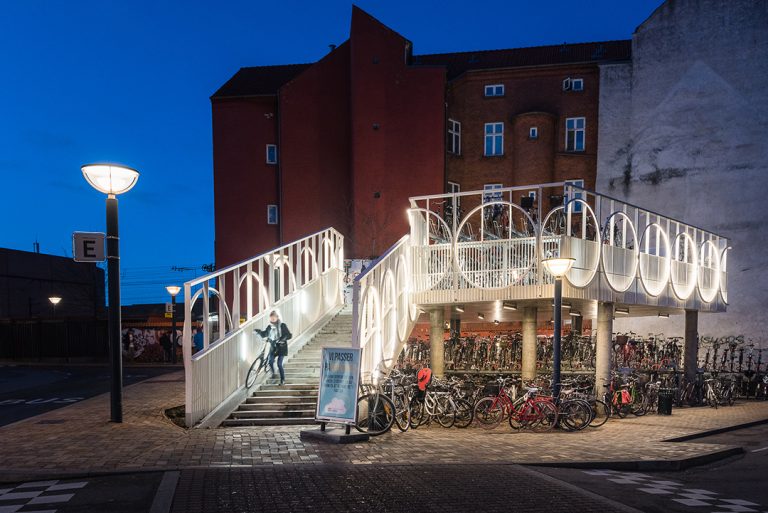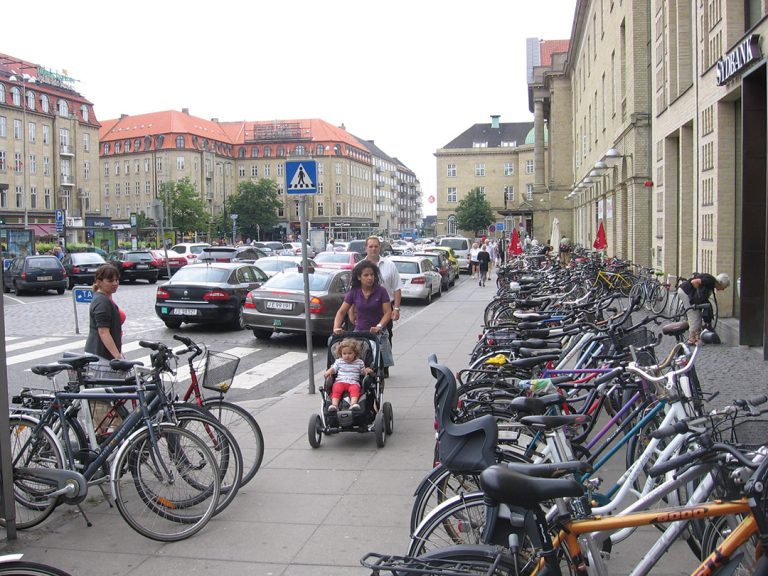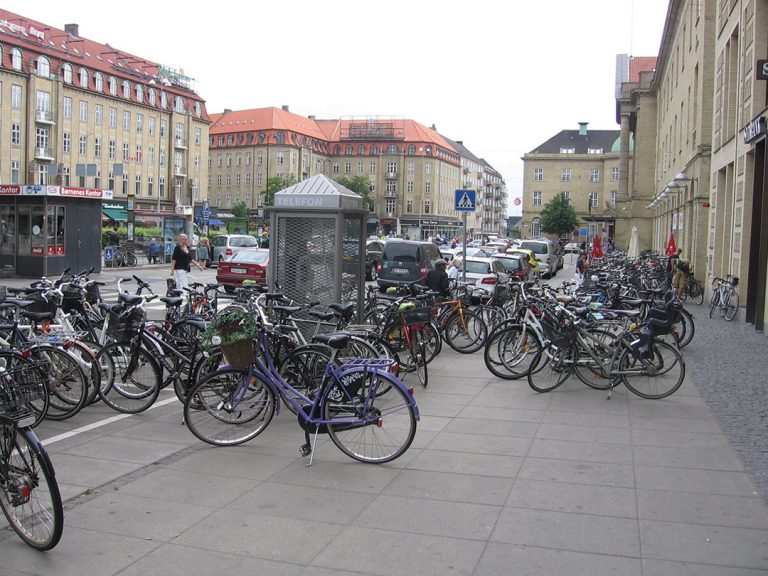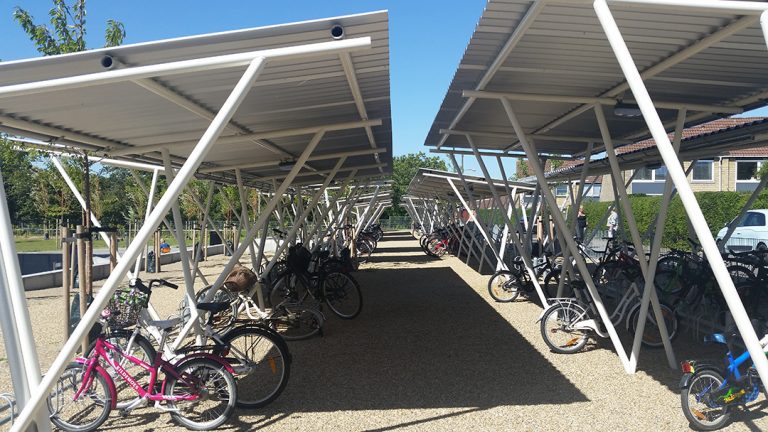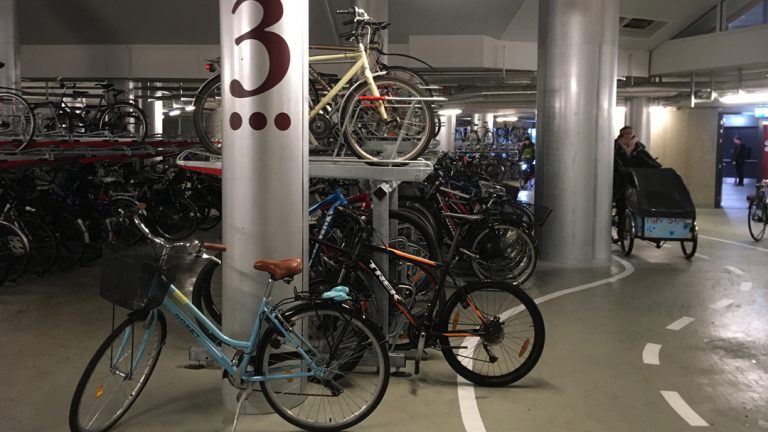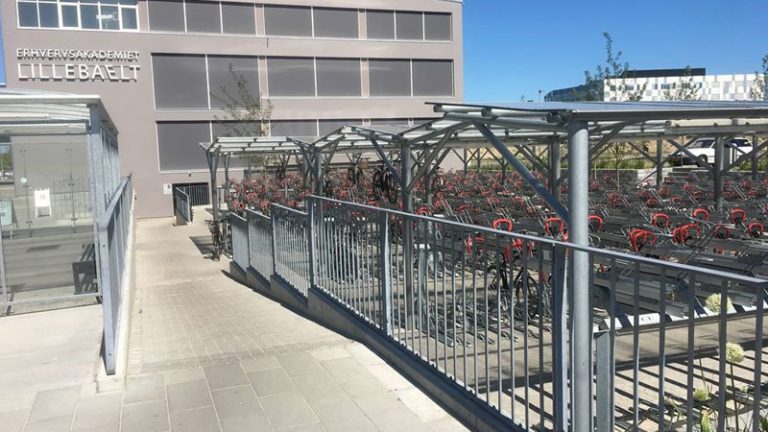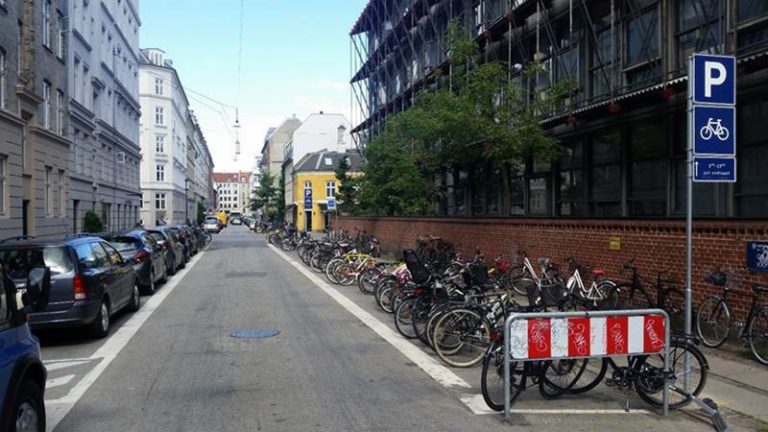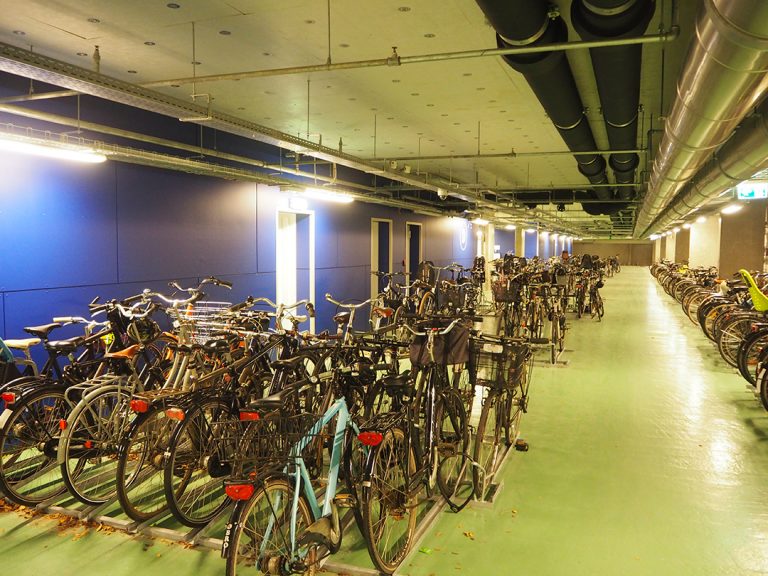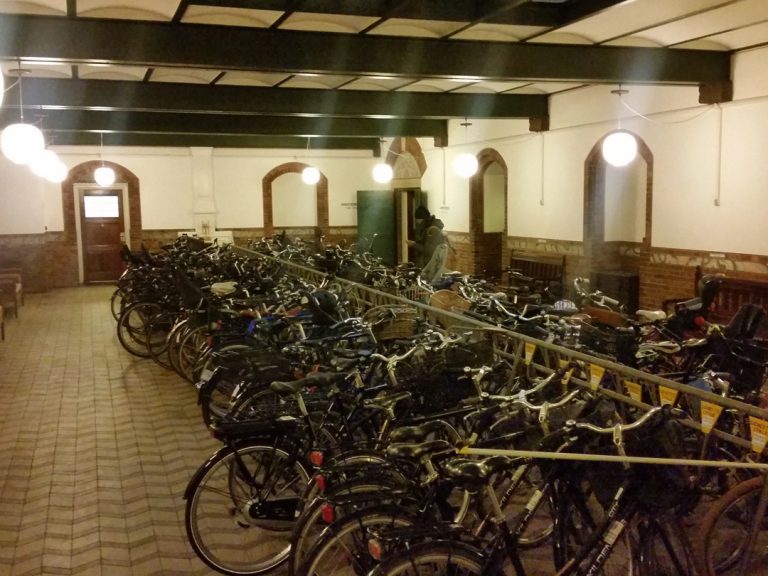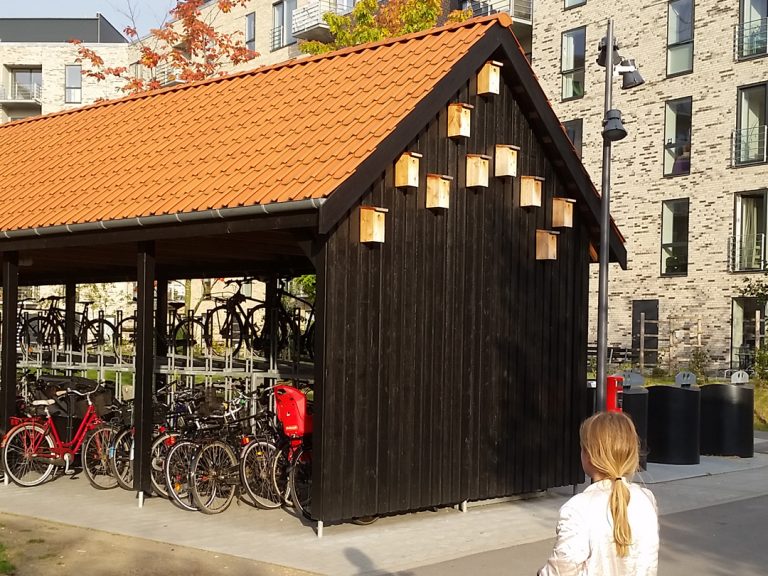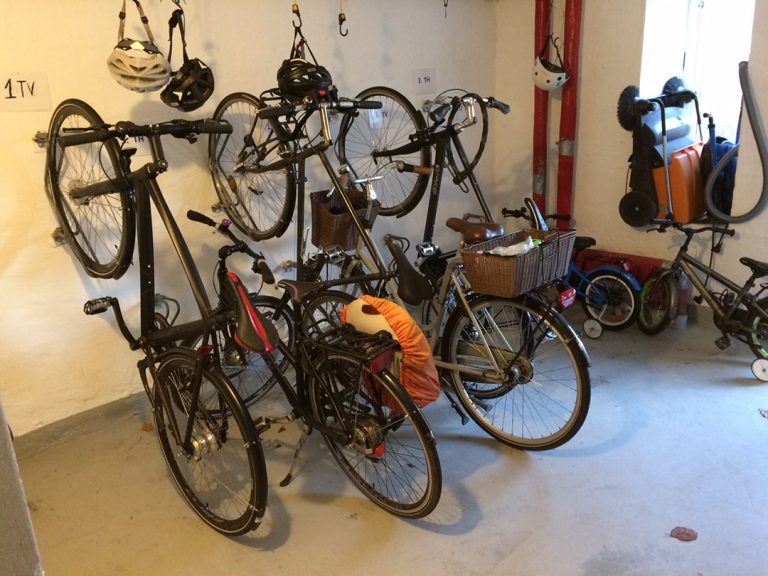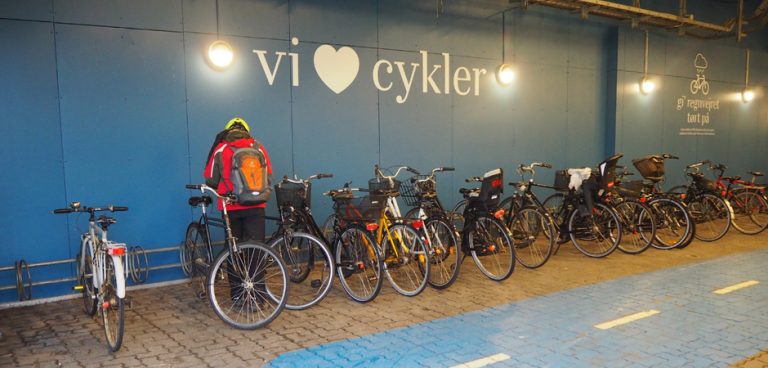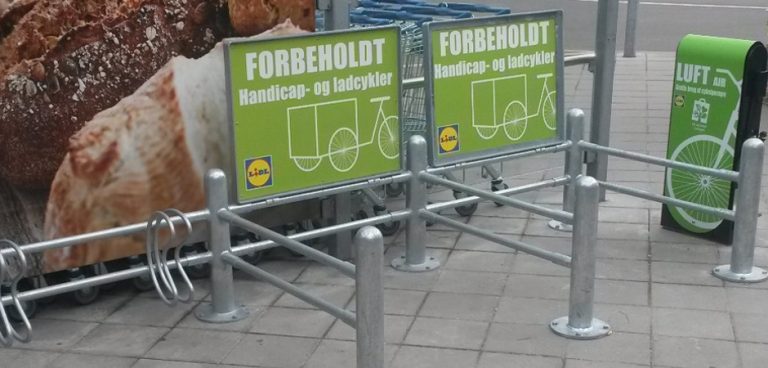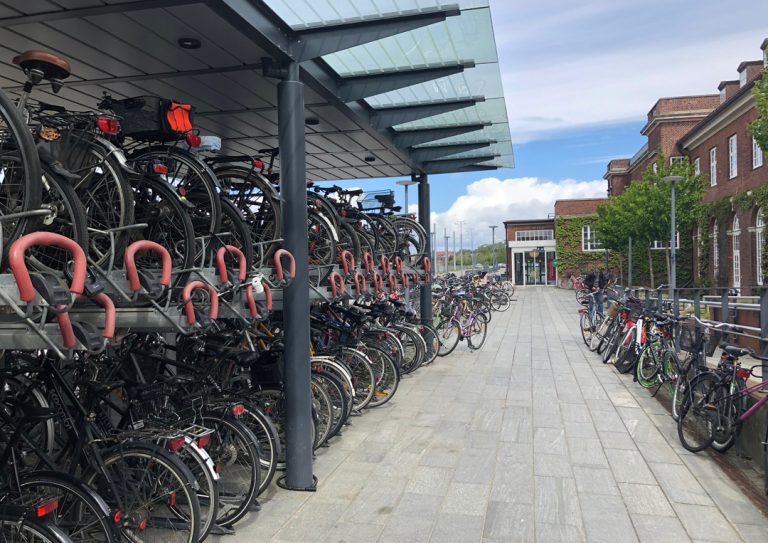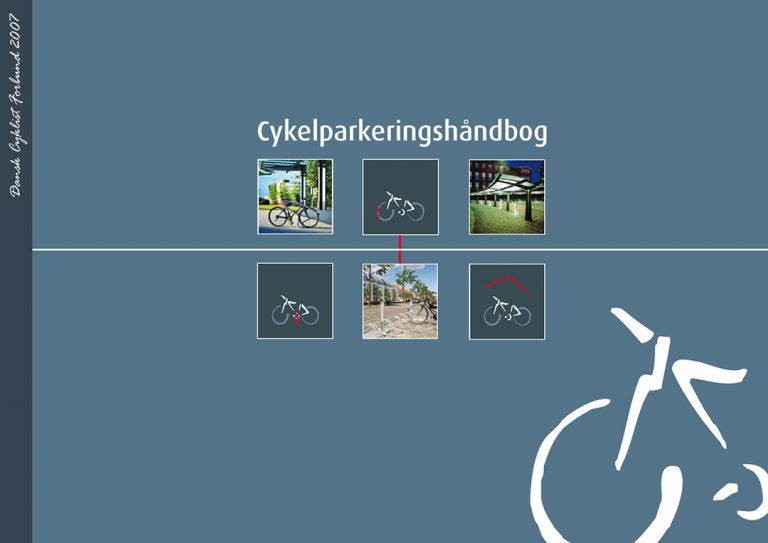Good bicycle parking isn’t rocket science – just get it right
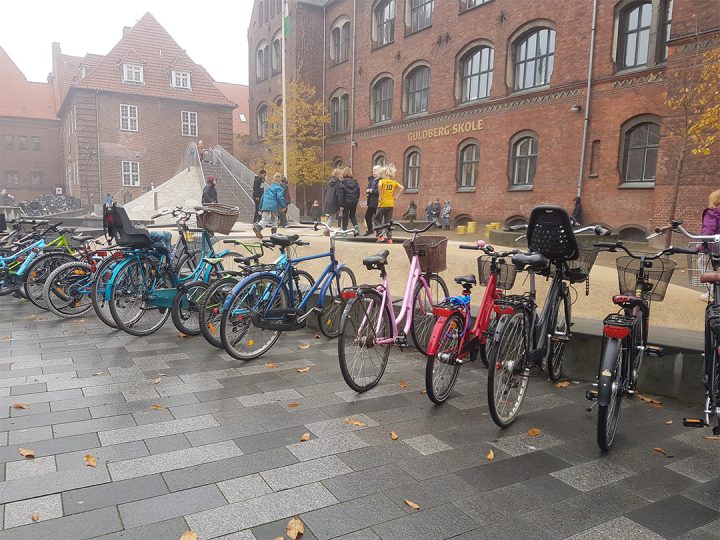 Photo: Guldberg School, Nørrebro, Copenhagen /Gehl Architects; 3 in 1 : bench, demarcation, AND the facility is easily accessible and monitored.
Photo: Guldberg School, Nørrebro, Copenhagen /Gehl Architects; 3 in 1 : bench, demarcation, AND the facility is easily accessible and monitored. Good bicycle parking facilities are easy to install PROVIDED the local authority has the will to allocate funds for construction and cleaning, and ensure the correct location and sufficient space. However, if this is not the case, you can talk all you want about bicycle parking, and organize endless brainstorming sessions and workshops without producing good results.
By Andreas Røhl & Anne Severinsen, Gehl
There are many excellent Danish examples of well thought-out and well- functioning bicycle parking facilities. And perhaps there are even more examples of mediocre and decidedly bad solutions, or simply no solutions at all. Fortunately the trend is going in the right direction, and more and more shops, residences and workplaces are coming to realize the value of good bicycle parking facilities.
Good bicycle parking facilities are:
- Placed correctly
- Comfortable
- Visible and easily understandable
- Differentiated
- Secure and safe
- Available
- Looked after and cared for
- A signal that cyclists are respected
- More than just a parking facility
Good bicycle parking facilities are …
… placed correctly. They should be placed as close to the destination as possible and with the least deviation. Their placement should be easily understandable, and designed according to the users’ desire line: where do users come from and where do they want to go?
… comfortable. There should be easy access to the parking facility, not merely measured in meters, but also measured in comfort. Ideally, it should be possible to cycle all the way up to the facility. Any ramps should have a low incline; doors should be wide, and either open automatically by a sensor or manually by pressing a button; bike racks should be easy to park in and not too close together. In the case of two-tier bike racks the type chosen should make the upper tier more easily accessible, and the facility should be covered when bicycles are parked for longer periods of time. Facilities with many spaces should have services, including changing rooms, air pumps, and numbers, colors, etc. that make it easy to find your bike.
… visible. The parking facility should be visible even at a distance. Good wayfinding guidance should clearly show the way.
… differentiated. Cyclists are different individuals with different errands and different types of bicycle. This complexity must be born in mind when designing a bicycle parking facility. Solutions must take account of elderly ladies with a heavy bicycle, the family with a cargo bike, the middle aged commuter with an e-bike, the child on a child’s bicycle with small wheels, and the young man with an expensive racing bike. Parking duration and time of day are also significant factors for what type of bicycle parking works best.
… secure and safe. The parking facility must be experienced as safe. A secure bicycle parking facility is light, open, well maintained, and there should be a flow of people or some other type of active or passive human surveillance as well as options for locking the bicycle. Bicycle parking in a construction should have several entrances and preferably an inward and outward line of sight.
… available. The number of spaces should match the number of users, and better 10 spaces too many than too few. A 10%-30% over capacity should be aimed at from the time of installation, and options for expansion should be factored into the design from the start.
… looked after and cared for. A bicycle parking facility is like a garden. It takes love and care to maintain it properly. It is therefore essential that the high quality of the physical solution is combined with continuous cleaning and removal of wrongly placed and abandoned bicycles. It is crucial to include the estimated level of clean-up from the start so the design can be adapted to the everyday activities that will begin after the festive speeches are over.
… a signal that cyclists are respected. Bicycle parking facilities are also communication. Poor facilities signal disorganization; they send the signal that cyclists are an inconvenience, and don’t need to be taken seriously. Good design signals organization; it sends the signal that cycling is taken seriously as an integrated part of the transport system, and that cyclists should be treated with respect.
… more than just a parking facility. Well- designed bicycle parking also means a well-organized urban space, good pedestrian accessibility, greater use of collective transport, support of local shops, a bench or a planting, and job creation for the unemployed who can be put to work tidying up parked bicycles.
- Architects The bicycle parking facility is easily accessible, placed so as to have a minimal impact on the walking line, the bicycle beds are sunk so the facility is less dominant in the urban space, and to clearly demarcate the parking area so there is less need to tidy up. Foto: Nørreport, København / Gehl
- Architects Easy access to the basement parking facility with direct access to the workplace. Well-lit, spacious, basement parking with services, including bicycle repair, changing rooms, and access to loan bikes and staff bikes. Photo: Nordea, Ørestaden, Copenhagen /Gehl
- Photo: Fisketorvet, Copenhagen /Gehl
- Shopping center with clear signage, extensive, high- quality bicycle parking, including special parking facilities for cargo bikes, do-it-yourself service, and a bicycle mechanic. Photo: Fisketorvet, Copenhagen/ Gehl
- Bicycle parking facilities must be maintained and cared for. This means there has to be someone to do the job. Above, bike butlers in action in Copenhagen. Photo: Bike butlers, Christiania Torv, Copenhagen / Gehl
- Safety means many things, but the main thing is that you can always find the bike where you left it when you need to use it again. Clamps in the ground that make locking a cargo bike more flexible are an example of a simple solution that significantly reduces the risk of theft. Photo: Frederiksberg, Copenhagen/ Gehl
Good examples of bicycle parking facilities
In urban spaces
The need for bicycle parking in urban spaces is virtually insatiable in many Danish cities, and if the challenge isn’t addressed pedestrians will be increasingly inconvenienced, the experience of urban space will deteriorate, and the quality of a cycling trip will diminish. The main challenge is to find and prioritize space, as well as ensure continuous tidying up, especially if no funds have been allocated to bicycle parking in construction.
- “The Pragmatic Move”: Bicycle parking facilities are established in small pockets wherever possible, for example in front of buildings, or they replace one or two car parking bays. Many, small solutions. Photo: Inner city, Copenhagen /Gehl
- “The Big Move”: Formerly a chaotic area in central Aarhus with bicycles scattered everywhere, now a simple, high capacity solution based on the will to prioritize space and establish an attractive area, combined with continuous tidying up. Photo: Immervad, Magasin, Aarhus / Gehl
Public transport
Many travelers combine cycling and train transport. There is consequently a great need for bicycle parking at stations. Countries such as Germany, Switzerland, and Holland are much more advanced than Denmark when it comes to the quality of bicycle parking facilities at train stations. However, there are also some good examples in Denmark.
The combination of busses (especially express and long-distance busses) and bicycles is widespread and has the potential of even greater volume. The Movia bus company has drawn up guidelines for good bicycle parking facilities at bus stops in their report on good transfer options between the bicycle and the bus.
- Central basement of good quality, including a design that makes it easier to remember where you parked your bike. Photo: Lyngby Station, Copenhagen / Gottlieb Paludan Architects
- Many types of solution supplement each other. The result is good access from all sides of the station, sufficient capacity, and the individual user can choose the solution he likes best. In addition, frequent tidying up contributes to a pleasant urban space. Hyppig oprydning bidrager til gode forhold og behageligt byrum. Photo: Odense Station Center, Odense /Thomas D. Mørkeberg
- Photo: Aarhus Station, Aarhus, CED 2012
- Photo: Aarhus Station, Aarhus, CED 2012
“It only takes five minutes”: Pictures taken before and after the area was tidied up illustrate how the combination of accessible bicycle parking and tidying up ensure good accessibility and a pleasant urban space for everyone near the station.
Schools and universities
Many children and young people cycle to schools or other educational institutions in Denmark. Danish cities such as Gladsaxe, Randers, and Odense have focused on creating good conditions for children cycling to school, including good bicycle parking facilities at schools. The typical issues confronting schools are not enough bike racks, poor quality bike racks, and the fact that the children’s bicycles are often stolen, which can be resolved with a different placement or video surveillance. Other educational institutions such as universities are also becoming increasingly aware of the importance of good bicycle parking facilities.
- Simple, ample, and well-functioning bicycle parking facility with good access and services such as air pumps and water. Photo: Bagsværd School, Gladsaxe /Gehl
- High quality bicycle basement with excellent location and easy access. Photo: Panum, University of Copenhagen / Gehl
- Covered, modern two- tier bicycle parking facility. Photo: Erhvervsakademi Lillebælt /Troels Andersen
- Flex-parking: Rackless bicycle parking facility during school hours, car parking the rest of the day. Flexible use of a desirable area. Photo: Gasværksvejens School, Copenhagen / Gehl
Workplaces
In Denmark, good bicycle parking facilities at the workplace are increasingly coming to be seen as HR on the same level as good working conditions and a good canteen. Bicycle parking facilities (including changing rooms) are increasingly factored in as a natural element when planning new construction, and bicycle parking facilities are upgraded in older buildings. Some local authorities have requirements for the extent, placement, and quality of bicycle parking facilities.
- Bank people bike to work too. The bicycle basement is of high quality with good accessibility and services such as changing rooms and loan bicycles. Photo: Nordea Bank, Ørestaden, Copenhagen / Gehl
- There were good bicycle parking facilities many years ago, too. A century old basement under Copenhagen Town Hall, easy access, good location, air pumps and water, and good materials. Photo: Copenhagen Town Hall, Copenhagen / Gehl
Residential areas
In Denmark it’s often the older buildings that lead the way when it comes to good bicycle parking facilities either because the facility was there to begin with, or because residents took the initiative for good indoor bicycle parking. Developers and architects are increasingly beginning to focus on bicycle parking combined with tougher local restrictions and often a quality boost for new construction.
- Recently constructed residential area with good bicycle parking facilities, easy access, special locks for cargo bikes, air pumps, options for expansion and multi-function, and with nesting boxes in the end wall. Photo: Frederiks Brygge, Copenhagen / Gehl
- Older buildings where the residents take the initiative themselves often come up with the best solutions, as shown above. There is a direct entrance from the street, numbered spaces, space-saving design, and hooks for clothing and helmets. The indoor parking facility is supplemented with short-term street parking. Photo: Sdr. Ringgade, Aarhus / Gehl
Shops
People on bikes shop, too, maybe not so much at a time, but more often. Shops in Denmark are increasingly coming to realize that cyclists are a significant customer group, and that installing bicycle parking facilities is cheap compared to the benefit, which can also measured in signal value. For more information on how cyclists are worth their weight in gold for cities see: http://asp.vejtid.dk/Artikler/2016/06-07/8442.pdf
- Shopping center with a focus on good bicycle parking facilities, and how to market them. Photo: Fisketorvet, Copenhagen / Gehl
- Lidl is an example of a chain store where the management realized that good bicycle parking facilities would provide a better shopping experience for a large segment of their customer base, and cheap marketing as well. Consequently they developed the concept and rolled it out. Photo: Lidl, Denmark /Gehl
Municipal norms for bicycle parking facilities
More and more Danish local authorities have a politically approved norm for the establishment of bicycle parking facilities at new construction. The norm ensures that bicycle parking is factored into all projects in the planning phase, and that funding is part of the budget from the start. When norms are being defined, considerations of simplicity and usefulness should be weighed against the need to differentiate between the function of different categories of buildings. The following categories are recommended as a minimum:
- Workplaces
- Educational institutions
- Collective traffic terminals
- Shopping centers
- Residential areas (blocks of flats)
- Cultural and sports establishments
- Squares and shopping streets
The City of Copenhagen, for example, sharpened the requirements for bicycle parking in new construction in the master plan of 2015, setting forth the qualitative and quantitative requirements for bicycle parking facilities. The qualitative requirements are as follows:
- Bicycle parking facilities shall be established so they are easily accessible to users.
- Bicycle parking facilities shall normally be established directly next to entrances.
- Covering can be established in sheds or as an integral part of the construction.
| FUNCTION | NORM | COVER REQUIREMENT |
| Residences * | 4 per 100m2 | Intel |
| Student housing | 4 per 100m2 | Min. 50% (baseline) |
| Senior housing and assisted living facilities | 1.5 per 100m2 | Min. 50% (baseline) |
| Workplaces generally* | 4 per 100 m2 | Min. 25% (baseline) |
| Educational institutions | 0.5 per student and staff | Min. 50% (baseline) |
| Shops * | 4 per 100m2 | Min. 50% (baseline) |
The norms for bicycle parking facilities should also cover expansion and reconstruction of existing buildings, including change in usage and special norms for special bicycles, for example cargo bikes and children’s bicycles.
The extent and quality of bicycle parking facilities (for example whether the facility should be established in the construction) is an important decision, and should be based on local analyses, including studies of the estimated impact the requirements will have on the entire urban space. Stiff bicycle parking requirements may actually be an advantage to the developer since they may mean correspondingly milder car parking requirements, which would significantly reduce construction costs.
Danish as well as Dutch experience shows that norms aren’t enough in themselves, since the more qualitative elements such as access, flows, and acceptable impact on other urban space, are difficult to quantify. It’s important that the norms are supplemented by fixed procedures to ensure that competent persons with a good understanding of cycling conditions and urban space approve the final design in a dialogue with the developer.
Introduction to types of bike racks
There are many different types of bike racks and stands. What type is best depends on the estimated user, the location of the bike rack, and operations and maintenance considerations. For more information on bike rack types, please see Danish Cyclists’ Federation bicycle parking manual.
Bike racks have undergone a major development in recent years, particularly when it comes to two-tier stands. Today the model of choice has gas struts and/or wheel channels to make it easier to use the upper level.
The typical Danish bike rack is a front wheel bike stand. Leaning bike stands are less common even though they’re easier when it comes to locking the bicycle frame. Danish cyclists don’t usually need to do this except at railway stations, etc.
- The standard model for two-tiered bike racks should have gas struts and/or wheel channels, as shown here at Horsens Station. Photo: Horsens Station, Horsens / Gehl
- Danish Cyclists’ Federation has published an exhaustive guide to bicycle parking, including detailed discussions of different types of double-level bike racks.
Sources:
- Superskiftet – en guide til gode skifteforhold mellem cykel og bus, Movia (2017)
- Cykelparkering i nybyggeri – Best practice og Københavnske erfaringer, Gehl for Københavns Kommune (2017).
- “Cyklister er guld værd for byerne”, Celis, Pablo & Nielsen, Malene Kofod, Trafik & veje, (Juni/juli 2016)
- ”Undersøgelse af cykelparkering / Vaner og adfærd ved cykelparkering i byen”, Rambøll for Københavns Kommune (2015).
- ”Idékatalog for cykeltrafik”, Cycling Embassy of Denmark (2012).
- ”Bedre samspil mellem cyklen og den kollektive trafik, Idekatalog”, Trafikstyrelsen (2009).
- ”Cykelparkeringshåndbog”, Celis Consult og Dansk Cyklist Forbund (2007)


